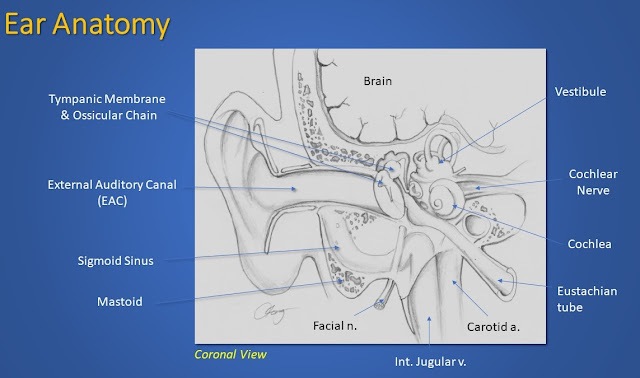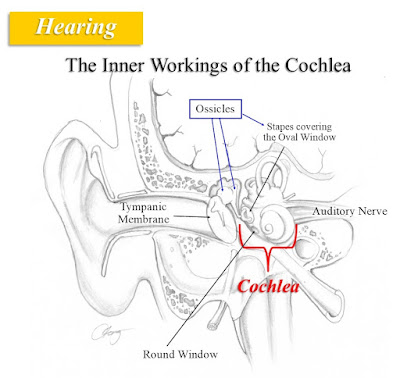Hearing loss is a common problem. Mostly the causes are benign in nature, such as hearing decline with aging or chronic loud noise exposure. Some folks attribute the problem to everone else: “You’re all mumbling! Can’t hear or understand a word you’re saying! All of you!” Another common concern is the need for hearing aids and the perceived stigma or problems with them. “I’m not going to use hearing aids! A friend of Joe’s brother had a hearing aid and he said they’re a pain to use. His dog even ate one!” But the problem may not be as simple as that, and there could be a more ominous probem. Thus, you’ll never know until your ears and hearing checked. How the Ear Processes Sound, covers in more detail the manner in which sound is received by the ear and transmitted to the brain, where all that juicy input is processed to make sense the sounds coming at you. This post explains the different types of hearing loss and the possible causes for each.
There are four sites in the ear and head where transmission of sound information from source to brain can be affected. These are: 1. The external ear, 2. middle ear, 3. cochlea (inner ear), 4. auditory nerve. The picture above shows the relevant anatomy. Think of it as a cut through somebody’s head (a coronal slice) and you’re seeing the structures on their right side.
The external ear includes the outer ear (auricle), which is that cone-shaped protrusion on the side of your head. Sound is funnelled from the auricle into that dark tunnel known as the external auditory canal (EAC for short). The sound is thus condensed in this tube and travels to the tympanic membrane (TM). So everything from auricle through th EAC to the TM is considered the outer ear.
The middle ear is the space between the TM and the cochlea. When sound hits the TM, it causes the TM to vibrate, or move back and forth rather rapidly. This vibratory motion is conducted along the 3 tiny bones called the ossicles. The ossicles act as little levers, converting the pressure energy of sound into mechanical energy by vibrating the ossicles and delivering that vibratory energy to the oval window of the cochlea (see figure below). The surface area of the oval window is much smaller than that of the TM, so that sound energy is amplified as it moves from a larger vibratory surface (the TM) to one that is much smaller (the oval window). Since it is an airspace, the middle ear is drained or ventilated through the eustachian tube.
The cochlea is a snail-shaped organ filled with fluid. It’s imbedded deep in your head in the temporal bone (the hardest in the body). You can’t see the cochlea since it’s on the other side of the TM. The mechanical energy created by the ossicles is then transmitted onto the oval window and into the cochlea, creating movement of the fluid in the channels of the cochlea, thus another type of mechanical energy. The fluid movement causes movement of a thin membrane inside those channels. Beneath the membrane are numerous hair cells which are attached to the membrane from beneath. Movement of these “hair” (cilia) on a given hair cell triggers a bunch of chemical reactions inside the cell, which ultimately create an electrical impulse that stimulates the neuron attached to that cell. You can check out Hearing and the Inner Workings of the Cochlea for more explanations and super-cool pictures (I’m patting myself on the back right now, if you haven’t noticed).
This leads us to the neural part of sound processing. The fluid energy of the cochlea is converted into a chemical process and then to an electrical energy that travels along the neuron to the brain. As it leaves the cochlea, this neuron joins with millions of other neurons to form the auditory nerve (Cranial Nerve VIII to be more scientific). This is also called the cochlear nerve, to add to the confusion. This nerve then travels to and enters the brainstem. The nerves travel upward to different brain structures and ultimately to the temporal lobes, located on the left and right sides of the brain. The brain then processes those neural signals and allows you to interpret what you’re hearing.
Types of Hearing Loss
Depending on where the problem arises in the ear, determines the type of hearing loss, which is important to render the proper treatment. Here we go:
Conductive hearing loss (CHL): this arises when there is a problem in outer ear. The problem arises from the EAC (again, the hole in your ear traveling deep into darkness, where one is tempted to place Q-tips or other foreign objects) or the middle ear, the part of the ear that includes the tympanic membrane (TM) and the ossicles attached to it. Problems arising from the EAC include some type of blockage such as ear wax, a foreign body, or a tumor. Middle ear problems include a hole in the TM (tympanic membrane perforation), otitis media (where there is pus or fluid in the middle ear behind the TM), stiffness of the ossicles (such as otosclerosis), eustachian tube problems, to name a few.
Sensorineural hearing loss (SNHL): The cochlea is the snail-shaped sensory organ that ultimately receives input from the TM and ossicles. It is connected to the brain by the auditory nerve (a.k.a cochlear nerve). Hearing loss due to a problem with either the cochlea (sensory) or the auditory nerve (neural) is combined into the nifty term sensorineural hearing loss, since it is often difficult to determine whether the cochlea or the nerve or both are affected. One of the most common causes of SNHL is loud noise exposure. Loud noise typically affects the hair cells of the cochlea. SNHL also often occurs as a normal decline of hearing with aging, known as presbycusis.
In some cases, only the auditory nerve (also called the cochlear nerve) is involved. An example of this is an acoustic neuroma, which is a benign tumor arising from the sheath of the nerve. Since the cochlear nerve is located in a bony canal, growth of such a tumor can compress on the nerve and cause hearing loss. Also, problems along the path of the auditory nerves as they travel in the brain can cause hearing loss, such as a stroke or tumor in the brain.
Mixed hearing loss (MHL): This arises when both a conductive AND a sensorineural hearing loss is present. For instance, a hole in the tympanic membrane in a patient with noise-induced SNHL will create a mixed loss, or an elderly patient (with presbycusis, or age-related SNHL) with otitis media (fluid behind the TM). In both examples, the defect in middle ear prevents proper conduction of sound from the TM down the ossicular chain creating the CHL. The defective cochlea or nerve (such as from prior noise injury or aging) creates the SNHL.
One readily-available method to assess hearing are tuning fork tests. Without getting into too much detail, these tests can determine if one side is worse and can give some information if loss is conductive versus sensorineural.
A more accurate method, which is the standard means to measure hearing, is the audiogram. We’ll cover this in another post. The primary gist of this is to make you aware of potential causes of hearing loss that may need treatment beyond hearing aids.
©Randall S.
Fong, M.D.
For more topics on
medicine, health and the weirdness of life in general, check out the rest of
the blog site at randallfong.blogspot.com


Comments
Post a Comment